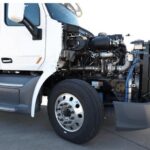Understanding the intricacies of your Audi 4.2 V8 engine can be crucial for maintenance and repairs. This guide provides a detailed overview of the engine diagram, highlighting key components and their connections. We’ll explore various diagrams and schematics to help you navigate the complexities of this powerful engine.
Decoding the Audi 4.2 V8 Engine Bay
The engine bay of the Audi 4.2 V8 is a complex network of interconnected parts. Let’s break down the common vacuum connections and other essential components using provided diagrams:
Vacuum Connections and Sensors
This diagram illustrates the main vacuum connections within the engine bay, indicated by black arrows.
This image provides a closer look at specific vacuum lines and their routing.
Several crucial sensors play a vital role in engine performance:
-
Mass Air Flow (MAF) Sensor (G70): Measures the amount of air entering the engine, crucial for fuel injection calculations. Often integrated with the Intake Air Temperature (IAT) sensor (G42).
-
Camshaft Position (CMP) Sensors (G40 & G163): Monitor the position of the camshafts, ensuring proper timing for valve operation and ignition. Located on cylinder bank 1 (G40) and bank 2 (G163).
-
Engine Coolant Temperature (ECT) Sensor (G62): Measures the engine coolant temperature, influencing fuel injection and other engine parameters.
-
Engine Speed (RPM) Sensor (G28): Located in the transmission housing, this sensor measures engine speed.
-
Knock Sensors (G61, G66, G198, G199): Detect engine knocking and adjust ignition timing to prevent damage.
Actuators and Valves
This diagram showcases the location of various actuators and valves.
Key actuators and valves include:
-
Evaporative Emission (EVAP) Canister Purge Regulator Valve (N80): Controls the flow of fuel vapors from the EVAP canister to the engine for combustion.
-
Throttle Valve Control Module (J338): Controls the throttle valve opening, regulating air intake and engine power. Includes integrated throttle position sensors (G187 & G188).
-
Camshaft Adjustment Valves (N205 & N208): Control variable valve timing, optimizing engine performance and efficiency.
-
Secondary Air Injection (AIR) Solenoid Valve (N112) and Pump Motor (V101): Introduce air into the exhaust system during cold starts to reduce emissions.
-
Intake Manifold Change-Over Valve (N156): Adjusts the length of the intake runners for optimal performance across different engine speeds.
Electrical Components and Relays
This image highlights a connector console and its pin assignments.
The Audi 4.2 V8 relies on various electrical components and relays:
-
Ignition Coils: Provide high voltage to spark plugs for ignition.
-
Fuel Pump Relay (J17): Controls power to the fuel pump.
-
Secondary Air Injection (AIR) Pump Relay (J299): Controls power to the secondary air injection pump.
-
Motronic Engine Control Module (ECM) Power Supply Relay (J271): Provides power to the engine control module.
This diagram illustrates the location of key relays in the vehicle.
Understanding the Diagrams
This image provides a detailed view of the intake manifold area, including knock sensors and the change-over valve.
This diagram highlights the location of key sensors and actuators on the engine.
These diagrams, while complex, offer a valuable resource for understanding the layout and function of the Audi 4.2 V8 engine. By familiarizing yourself with these components, you can better diagnose issues and perform maintenance on your vehicle.
Conclusion
The Audi 4.2 V8 Engine Diagram provides a roadmap to this powerful and sophisticated engine. Understanding the location and function of its various components is essential for any enthusiast or mechanic. While these diagrams offer a comprehensive overview, consulting the official Audi service manual for your specific model year is always recommended for detailed information and repair procedures.
